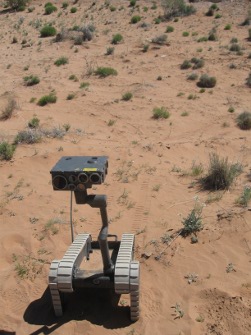Bye-Bye to Army Minirobot?
I've met the Army's battlefield minirobot -- which goes by the official moniker of Small Unmanned Ground Vehicle -- twice over the past year on trips to White Sands Missile Range in south central New Mexico. I have to say it's one mighty impressive and cute little critter.
Small Unmanned Ground Vehicle

Photo credit: Bob Brewin
I've met the Army's battlefield minirobot -- which goes by the official moniker of Small Unmanned Ground Vehicle -- twice over the past year on trips to White Sands Missile Range in south central New Mexico. I have to say it's one mighty impressive and cute little critter.
But, as my colleague Megan Scully of Congress Daily reported on Thursday, cute doesn't cut it with Rep. Adam Smith, D-Wash. He's chairman of the Armed Services Committee's Air and Land Forces Subcommittee and he wants to zero out funding in the fiscal 2011 Defense Department authorization bill for the minirobot, which is made by iRobot, the outfit that gave the world its first smart vacuum cleaner. Smith nixed $20 million for the robots because they weigh too much and have a hard time seeing at night.
He also wants to kill what I call the Flying Beer Keg, a small unmanned aerial vehicle, built by Honeywell Aerospace, because tests indicate it is "too loud and has too short a range to be tactically useful in many operations."
The latest version of The Flying Beer Keg that I saw at White Sands in April made considerably less noise than an earlier version, so maybe there's hope for this gizmo as the Army continues to conduct field tests for the systems designed to provide modernized infantry brigades with battlefield smarts.
Paul Mehney, spokesman for the brigade modernization project, told me these tests are critical because if the systems -- which also include unmanned sensors -- don't pass muster, "We're not going to field them."
'The Flying Beer Keg'

Photo credit: U.S. Army
NEXT STORY: Health IT Cuts Heart Attack Risk



